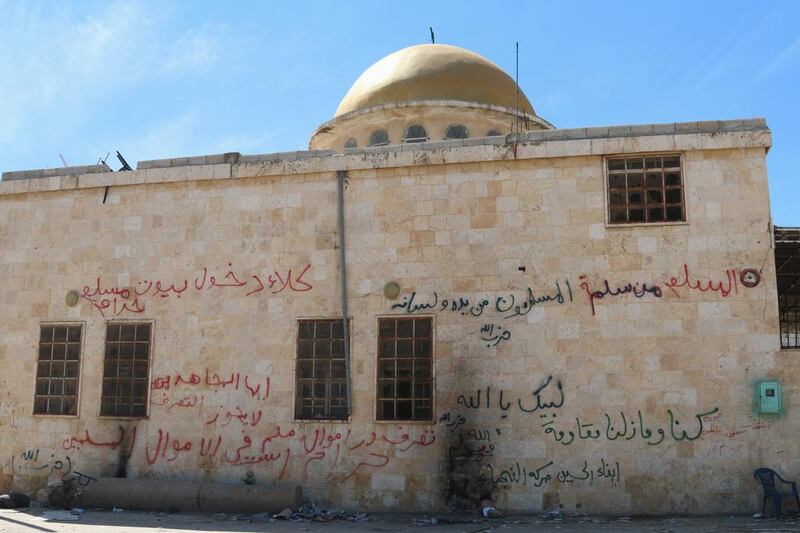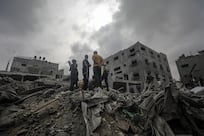Over the weekend, the Syrian rebels went back to fighting. Around 40 days into a relative lull after the rebels agreed to a cessation of hostilities deal with the regime, battles erupted in at least five different regions throughout the country. Their development can help us understand the extent to which the Russian intervention in Syria has helped prop up Bashar Al Assad’s army, especially in light of the regime’s hyped seizure of Palmyra last week.
In southern Aleppo, the antigovernment forces led by Al Qaeda-affiliated Jabhat Al Nusra took Al Eis village along with a strategic hilltop that overlooks the Aleppo-Damascus highway.
After Al Eis was taken, battles continued in another area known as Al Hadher, which includes a major base for troops and foreign militias affiliated to the regime.
In the coastal region, the rebels seized at least eight villages and hilltops along the Akrad Mount, the site of a major Russian air offensive last year. The ability of the rebels to control areas in the Akrad Mount is striking, considering that resistance in that region was all but broken by the heavy-handed Russian campaign there.
Clashes also erupted near Damascus between the regime and Jaish Al Islam. Elsewhere, the rebels launched offensives against ISIL and its allies in northern Aleppo and Deraa. The rebels defeated ISIL in three areas in the north and pushed out extremist forces, widely labelled as loyal to ISIL, in the south.
These clashes took place as eyes were on the regime’s battles against ISIL in Homs after the group was driven out of Palmyra last week. The active fronts also come a week before the planned resumption of the peace talks between the government and opposition in Geneva.
By battling ISIL, both sides want to present themselves as capable allies against the extremists. But the battles in Aleppo and the coastal region are important for other reasons.
For the first time since September, when the Russians intervened in Syria, the takeover of Al Eis shows the regime still relies heavily on foreign militias and Russian air strikes. What makes the battle in Al Eis particularly revealing is that there were no Russian air strikes, although the offensive was led by Jabhat Al Nusra – a group exempted from the cessation of hostilities.
A local reporter embedded with the rebels told Dubai's Orient News that no Russian air strikes had targeted the antigovernment forces. A member of Jabhat Al Nusra told the same channel that the clashes lasted for at least seven hours. A common new tactic by the regime is to increase the number of lines of defence, instead of fighting on one major front. He said that, after battling the front forces for several hours, they had an extra kilometre of intense fighting before they reached another line of regime-aligned forces, a tactic Jabhat Al Nusra overcame by deploying three suicide bombers.
The fact that anti-government forces fought for more than seven hours, from the evening until after midnight, and that Russian jets were not deployed to repel Jabhat Al Nusra’s attack indicates that Moscow wanted to send a message to the regime that pro-government forces would not withstand such advances without Russian air strikes. According to a well-placed source, US military experts working with the opposition from Turkey indicated that they “had no objections” to the offensive against the regime.
Also, according to the reports from southern Aleppo, most of the forces guarding the village and hilltop were foreign militias. Hizbollah reportedly announced the deaths of about 10 fighters, including a Sunni Lebanese fighter from the resistance squads that are beholden to it. The pre-eminence of foreign militias in Al Eis shows that the regime continues to rely on those militias to conduct its war outside its heartlands. Iranian-backed militias also spearheaded the capture of Palmyra.
Another factor that makes the fighting in Al Eis more damning to the regime is that Jabhat Al Nusra took the same area this time last month but was swiftly driven out by Russian air strikes.
The regime, then, had experience battling Jabhat Al Nusra in that area and had a month to secure the village and the hilltop, but it failed to do so. With the help of Russian air strikes, regime troops may ascend the hilltop, but the message should be clear: unlike the opposition that is fighting on multiple fronts, the regime army is still too weak to hold its ground, much less to take Aleppo or any other major areas without close air support from Russia.
Hassan Hassan is a resident fellow at the Tahrir Institute for Middle East Policy and co-author of ISIS: Inside the Army of Terror
On Twitter: @hxhassan





